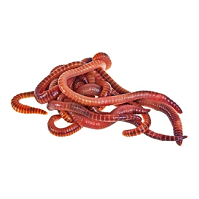Red worms: Where to buy them
Red worms: Where to buy them
Blog Article
Whatever You Required to Know Concerning Red Wigglers for Composting
Red wigglers, or Eisenia fetida, play a pivotal role in the world of composting, changing organic waste into beneficial dirt changes. The process of setting up a worm container and preserving it can position challenges.
What Are Red Wigglers?

(red wiggler compost bin)
Indigenous to North America, red wigglers are surface-dwelling organisms that choose moist, warm environments rich in disintegrating natural matter. Their diet plan consists mainly of rotting plant material, food scraps, and other organic particles, which they consume and break down effectively. As they digest this material, they generate nutrient-rich spreadings that improve soil fertility.
Red wigglers are hermaphroditic, having both male and female reproductive body organs, and can reproduce swiftly under optimum conditions. Generally, red wigglers are vital contributors to the procedure of reusing organic waste into beneficial compost.
Benefits of Utilizing Red Wigglers
Making use of red wigglers in composting systems offers many benefits that enhance both the effectiveness of waste administration and the top quality of the resulting compost. These worms, clinically understood as Eisenia fetida, are specifically effective at breaking down organic issue, transforming kitchen scraps and yard waste into nutrient-rich compost at an increased price.
Among the primary benefits of using red wigglers is their capability to take in huge amounts of natural product, often refining their weight in food waste daily. This high consumption rate leads to faster decomposition and decreases the volume of waste sent to garbage dumps. Moreover, the spreadings created by red wigglers are abundant in necessary nutrients, beneficial microorganisms, and enzymes, making them an excellent fertilizer for gardens and plants.
Additionally, red wigglers flourish in a variety of environments, making them versatile for both interior and outside composting systems - red wigglers. Their existence in a compost bin aids to freshen the material, avoiding odors and advertising a healthy and balanced composting process. In general, employing red wigglers not just adds to efficient waste management yet additionally supports sustainable horticulture methods through the manufacturing of high-grade garden compost
(red wiggler earthworms for sale)
Setting Up Your Worm Container
To efficiently establish a worm bin, it is vital to select an ideal container that meets the needs of red wigglers while offering a favorable setting for composting. An ideal bin can be made from plastic, wood, or steel, with a capability of at the very least 1 square foot for every single pound of worms.
Guarantee the container has appropriate drain openings to stop excess dampness, as red wigglers grow in a damp, but not waterlogged, environment. red wigglers. The bin ought to also be ventilated to offer adequate air flow, avoiding anaerobic conditions that might hurt the worms
A suitable place for the worm bin is an amazing, dark location, devoid of direct sunlight and extreme temperatures, as red wigglers prefer a temperature variety of 55 to 77 levels Fahrenheit.
Prior to presenting the worms, prepare bed linen materials such as shredded newspaper, cardboard, or coconut coir, which will certainly give find out here now both environment and food. Moisten the bedding gently to develop an inviting atmosphere for the worms. Lastly, consider positioning a cover on the bin to maintain moisture and minimize bugs, while ensuring it can be easily gotten rid of for upkeep.
Feeding and Treatment Guidelines
Feeding red wigglers is an essential aspect of maintaining a healthy and balanced composting system. These worms prosper on a diverse diet, mostly composed of natural materials such as fruit and veggie scraps, coffee premises, and crushed eggshells. It is crucial to prevent feeding them meat, dairy, and oily foods, as these can develop unpleasant smells and attract parasites.
When introducing food to your worm container, slice or shred products into smaller sized pieces to promote quicker decay. Start with percentages to assess the worms' consumption rate, progressively enhancing the amount as they adapt. It is a good idea to alternate feeding places within the container to motivate detailed mixing and oygenation of the garden compost.

Troubleshooting Common Issues
Preserving a prospering worm composting system can often provide difficulties that require attention and troubleshooting. Usual concerns include an unpleasant odor, which often shows overfeeding or the visibility of anaerobic problems. To fix this, decrease the amount of food included and make sure proper aeration by blending the bed linen material.
An additional regular problem is the escape of worms from the container. This can happen due to too much wetness or unsuitable ecological problems. Frequently check the dampness levels, going for a moist but not soaked consistency, and keep ideal temperatures in between 60-80 ° F(15-27 ° C )to create a comfy habitat for your red wigglers.
Pests, such as fruit flies, can additionally get into worm bins. red wigglers. To battle this, cover food scraps with a layer of bedding or shredded paper to hinder flies from laying eggs. Furthermore, ensure that any type of food added is fresh and complimentary from mold, which can draw in undesirable bugs
Last but not least, if your worms seem non-active, look for stress and anxiety elements such as temperature changes or inadequate wetness. Addressing these typical concerns will assist keep a healthy and efficient worm composting system.
Verdict
In summary, red wigglers, or Eisenia fetida, play an important function in lasting waste administration via vermicomposting. Correct arrangement and maintenance of a worm container, along with adherence to feeding standards, ensure a thriving community that reduces garbage dump contributions.
Report this page